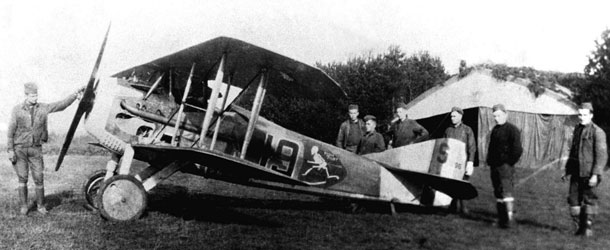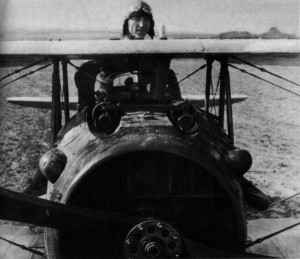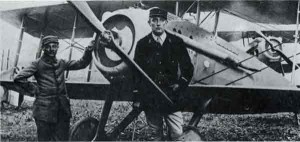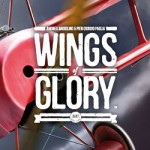Following the presentation article of the SPAD XIII, it's time to know something more about the pilots of the three versions of this fighter to be featured in the WW1 Wings of Glory Airplane Packs.
"Eddie" Rickenbacker
Born October 8, 1890, Edward Vernon Rickenbacker was the son of German-speaking Swiss immigrants who had settled in Columbus, OH. Before WW1, he was a successful driver, earning the nickname "Fast Eddie". Intensely patriotic, Rickenbacker immediately volunteered for service upon the United States' entry into World War I. Assigned as personal driver for the commander of the American Expeditionary Force, General John J. Pershing, he anglicized his last name (originally Reichenbacher) to avoid anti-German sentiment.
Requested to repair the car of the chief of the US Army Air Service, Colonel Billy Mitchell, he got the chance to become an air pilot, and though considered old (he was 27) for flight training, Mitchell arranged for him to be sent to flight school at Issoudun. Upon completion of training, he was retained as an engineering officer due to his mechanical skills. Flying during his off hours, he applied to Major Carl Spaatz for permission to join the newest US fighter unit, the 94th Aero Squadron, and arrived at the front in April 1918.
He flied his first mission on April 6, 1918. The first victory came on April 26, while flying a Nieuport 28, when he brought down a German Pfalz. On May 30th, he achieved the status of ace after downing two Germans in one day. The 94th adopted the newer and stronger SPAD S.XIII in August, and Rickenbacker scored 20 of his 26 victories with this fighter - the last one was on September 30th. He became the top American scorer of the war and the most celebrated aviator in America, and was awarded with the Medal of Honor.
After the WW1, Rickenbacker worked in the auto industry. He started the Rickenbacker Motors in 1922, then in 1927 he purchased the Indianapolis Motor Speedway. In 1938 he bought the Eastern Air Lines. Rickenbacker volunteered his services to the government by the outbreak of World War II, and visited various Allied bases in Europe to assess their operations. Dispatched to the Pacific, his airplane went down in the sea and together with 6 companions he survived 24 days adrift on life rafts. After the war conclusion, Rickenbacker returned to Eastern Air Lines and remained with the company until 1963. He died at Zurich, Switzerland, on July 27th, 1973, after suffering a stroke.
Georges Madon
The fourth ranked French ace pilot of the WW1, Georges Felix Madon was born at Bizerte, in Tunisia, on July 28th1892. His interest in aviation started soon: he was just 15 years old when he made an unsuccessful attempt to build his own craft.
His desire to fly led him to made several attempts to become a pilot. Enlisted in the First Engineering Regiment in Versailles, he ended up as a cook, but repeatedly requested pilot's training. In June 1911 he was qualified as a pilot, and enlisted in the French military he received his military pilot's license at Avord, France, in January, 1913. He originally flew reconnaissance and the first ever night-time bombing missions, with Escadrille BL30.
In April, 1915, thrown off course by heavy fog, he flew into Swiss air space and was interned for several months. After two tries to escape, he freed himself in December by chloroforming and kidnapping his guard, and was rewarded with a court-martial and 60 days confinement. He was then posted to Escadrille MF218 and after a request was transferred to a fighter squadron, the N38, in September 1916.
By July 1917, he had 12 victories; in October his confirmed score was 17, with 20 victories unconfirmed. By March, 1918, his personal score stood at 25 confirmed. By this time he was appointed to command Escadrille Spa38, which was re-equipped with new Spad XIIIs. Although principally a photo reconnaissance unit, this squadron aggressively defended itself, with their commander motto "Whoever rubs against me gets pricked". The Spa38 also adopted his black thistle insignia on their planes.
By war's end, Madon was credited with 41 confirmed victories and 64 probable. With seven years flying experience, he was one of the world's most experienced aviators at the time. Madon stayed in aviation after the war ended. He died six years after Armistice Day, at age 32, killed in his native Tunisia preparing for a tribute to fellow airman Roland Garros. His aircraft suffered mechanical trouble, and he gallantly crashed it into the roof of a villa rather than hit spectators.
Madon was awarded three medals by his own country, Médaille Militaire, Chevalier de la Légion d'Honneur and Croix de Guerre with ten palms. He also was awarded the Italian Order for Valor, and the Romanian Order for Valor.
Arthur Coadou
The French Sous Lieutenant Arthur Marie Marcel Coadou is an ace credited with nine confirmed aerial victories out of his fifteen combat claims. He was born on 7 February 1897. Volunteered for military for the war's duration, he was sent to aviation training in July 1915, being transferred onward to Etampes for pilot training on September 22nd and receiving the Military Pilot's Brevet No. 2445 in January 1916.
Coadou was first assigned to 13e Groupe d'Aviation, then to Escadrille C59. On 25 January 1917 he began further training, and on May 4th he was assigned to Escadrille 88 to fly SPAD fighter aircraft. He scored his first verified aerial victory on 19th that month, and he downed a German Fokker D.VII on August 1st. On September 4th he shared a win with François Delzenne, and continued to score victories through the end of the war. By the end of the WW1, Coadou had flown 732 hours and fought in 59 dogfights.
On 28 March 1919, he was appointed a Chevalier in the Legion d'Honneur as recognition of his wartime service. Coadou later served also in World War II.
Information sources: The Aerodrome, Wikipedia, Military Factory, WW1 Aviation, Fan d’Avions, Military History.












Follow Us on